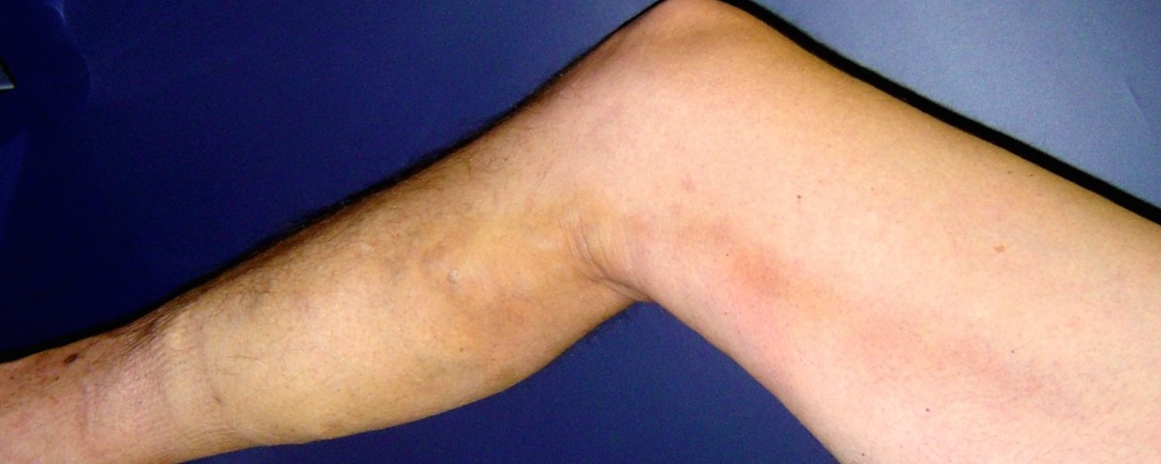Phlebitis & Thrombophlebitis Fort Worth, TX

Red streaks and swelling along the inner thigh demonstrating phlebitis (inflammation) along the course of the right great saphenous vein.
Phlebitis literally means inflammation in a vein. Most often the term is applied to the redness and tenderness of the skin and soft tissue associated with a blood clot in a superficial vein, usually in the leg. A common cause of phlebitis in the hand or arm is an IV catheter in hospitalized or surgical patients. In the legs, phlebitis commonly occurs spontaneously due to a blood clot in a superficial vein, termed thrombophlebitis. Patients with chronic venous disease and varicose veins are especially prone to this problem because the dilated varicose veins have sluggish or stagnant flow, making it more likely for the blood to clot. Prolonged bed rest, immobilization, pregnancy, obesity, and injury are common causes of thrombophlebitis. Inherited (genetic) disorders that raise the risk of blood clots is also a cause of thrombophlebitis. In and of itself, superficial thrombophlebitis is usually not dangerous, but numerous studies have demonstrated deep vein blood clots sometimes associated with superficial thrombophlebitis. Deep vein blood clots, or deep vein thrombosis (DVT) is a dangerous condition because the blood clots in these deep veins can dislodge and travel to the heart and lungs. In the lungs, these clots are termed pulmonary emboli, a serious and possibly fatal condition. In fact, about 50,000 Americans die of blood clots traveling from the extremities to the lungs each year. Diagnosis of acute deep vein thrombosis usually requires urgent treatment with blood thinning agents (anticoagulants) to prevents extension of the clot and the risk of the clot traveling in the circulation.
Call Today to Schedule Your Appointment
Causes of Thrombophlebitis
Thrombophlebitis may be caused by extended periods of inactivity; in some cases it may be the result of staying in bed during a long hospital stay or sitting for a long-period of time on an airplane flight. An injury to a vein may also cause a blood clot to form and the following factors may also increase a person's risk for developing thrombophlebitis:
- Varicose veins
- Pregnancy
- Birth control pills
- Hormone replacement therapy
- Smoking
- Inherited blood-clotting disorder
- Obesity
- Increased age
Superficial thrombophlebitis usually occurs in people with vein reflux and varicose veins. Certain medical conditions or blood disorders may also increase the risk of blood clots and thrombophlebitis.
Symptoms of Thrombophlebitis
If phlebitis is mild, it may not cause any symptoms at all. Superficial thrombophlebitis affects the veins closer to the skin and may cause pain, swelling and tenderness in the affected area. The area may feel warm or hot to the touch and it may appear as redness of the skin overlying the affected vein. The vein may feel like a hard cord beneath the skin, often very tender to touch or pressure.
Diagnosis and Treatment of Thrombophlebitis
Superficial thrombophlebitis is usually diagnosed through a physical examination by a physician. If deep vein thrombosis is suspected, a venous duplex ultrasound examination is usually the imaging study of choice. If pulmonary embolism is suspected CT or MRI is often performed. Other tests may be required, including tests to detect a genetic blood clotting abnormality, may be needed and ordered at the discretion of the physician.
Superficial thrombophlebitis is often treated with conservative methods that include heat packs to the affected area, elevation of the affected leg or limb, and over-the-counter nonsteroidal anti-inflammatory medications (NSAIDS). Drainage and evacuation of the blood clot can be done easily under local anesthesia and provides dramatic relief of the symptoms. More severe cases, particularly those that progress to deep vein thrombosis, may require additional treatments.
Prevention of Thrombophlebitis
While not all cases of phlebitis or thrombophlebitis can be avoided, there are simple precautions that can be taken to prevent the development of a blood clot in certain situations. When taking a long car or plane trip, walk or stretch your legs once in a while and drink plenty of liquids to stay hydrated. Lifestyle recommendations include:
- Staying physically active
- Smoking cessation
- Wearing support hose if you have vein disease
- Avoiding excessive weight gain
*The information about Phlebitis & Thrombophlebitis was reviewed by Board Certified Surgeon Dr. Michael Darnell. If you have any questions, please don’t hesitate to contact us using our contact form.
